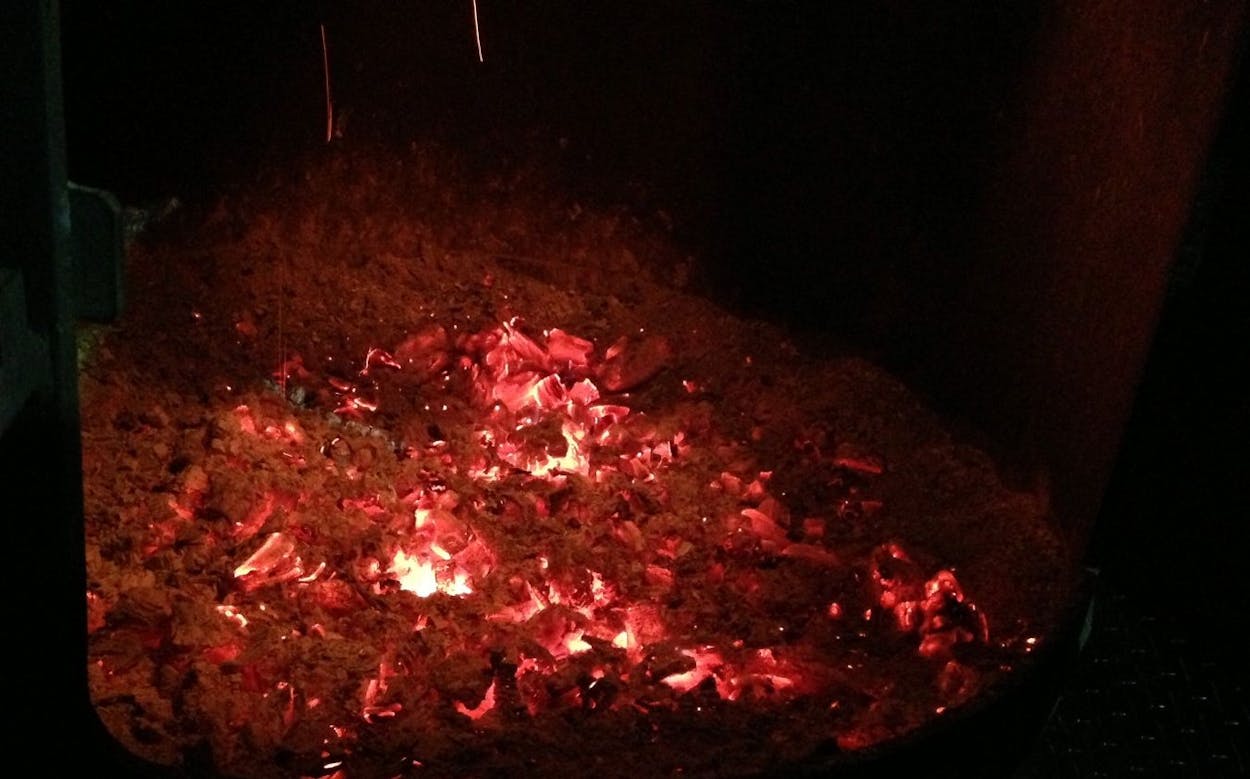“Barbecue isn’t supposed to taste like smoke. Real barbecue is cooked in a traditional open pit, not in a smoker.”
You may expect to hear these words from a North Carolina barbecue zealot who believes that cooking a whole hog over direct heat is the only permissible definition of barbecue. You might be surprised to learn that this was uttered by a Texan with a long history in barbecue. Bubba Roese was talking to barbecue cookbook author Robb Walsh while Walsh was attending a community barbecue in Washington, Texas, an anecdote well documented in the final chapter of Walsh’s Barbecue Crossroads book.
You may be expecting my rebuttal, but I’m not here to argue about what is and isn’t Texas barbecue. If it’s arguing you want, then go over to Meathead’s website, where he has a lengthy discussion about the definition of barbecue. I will only make some observations and ask a few questions about what we in the Lone Star State consider to be barbecue and how that differs (or doesn’t) from grilling.
You may have been told–or you may believe yourself–that barbecue is something that’s been smoked low and slow and that the exact opposite of Roese’s statement is the one true definition of barbecue. In fact, I may have told you that at one time. But at this point I’ve eaten too much barbecue in Texas to believe that either of those rigid interpretations of the word is correct–or even necessary. The barbecue establishments across this state offer numerous variations, and some of it is closer to grilling than you might find comfortable.

Let’s start with the big public barbecues held in Texas before the Civil War and continuing into the early twentieth century. These were massive events held to promote political debates, celebrate holidays like the Fourth of July, or to mark the completion of a new rail line. The citizens didn’t round up all their backyard offsets smokers onto the town square to feed the masses. They dug a pit. An unnamed observer from St. Louis described one of these public barbecues in Fort Worth in 1885, which the August 14th edition of the Fort Worth Gazette published: “Great trenches were dug in the beautiful grove west of the city and filled with logs of wood. These were fired long before they were needed for cooking, so that great beds of live coal, 4 feet wide, 3 feet deep and 20 long, were ready for the animals to be put upon.” This was direct-heat cooking on a grand scale with whole goats, sheep, and steers cooked over the coals. But did it taste like barbecue? According to the description, “There was a woodland flavor in it as though the perfumes of the forest had somehow been brought into essences and used for dripping.” Bubba Roese would have approved of the technique, but the resulting flavors may have been too smoky for him.

This method of cooking large hunks of meat directly over a fire in a trench may seem like an old fashioned way to do it, and most health departments would agree, but direct-heat cooking is alive and well in Texas. You’ll find massive steel chambers out behind barbecue joints in the Hill Country, where wood is burnt down to coals. These chambers are bent and blistered by roaring fires, but meat never gets near them. The fiery coals are shoveled by pitmasters into steel pits, and meats is cooked on grates directly over the coals lining these enclosed chambers. We call this direct-heat cooking–not grilling–and it is essentially the same technique used in those nineteenth-century public barbecues. Nobody who eats at Cooper’s Old Time Pit Bar-B-Que in Llano, which famously uses the direct-heat method, argues about whether they’re eating barbecue or grilled meat. Their mouths are too full of brisket.
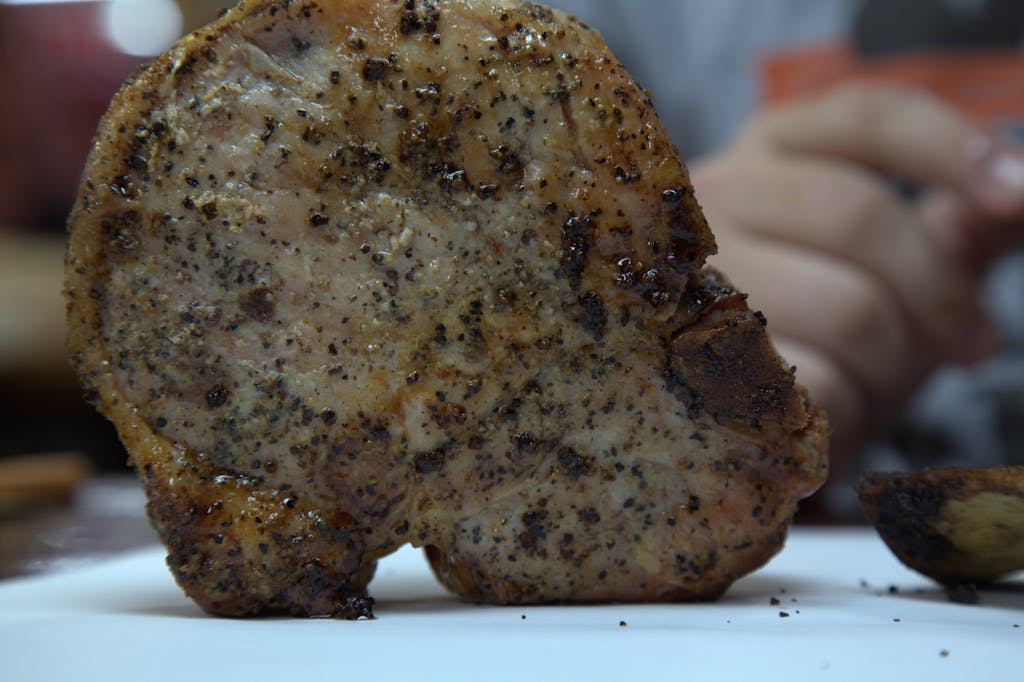
Steel offset smokers painted flat black can be found in backyards all over Texas, but how traditional are they? Brick smokers are in some of Texas’s most historic barbecue joints like Smitty’s in Lockhart, but the backyard variety didn’t come into common use until the eighties when companies like Pitts and Spitts in Houston, Lyfe Tyme in Uvalde, and New Braunfels smokers started making them for the retail market. The Weber kettle grill, on the other hand, was created in 1952. The legendary Sunset Barbecue Book, first published in 1938, included fourteen different plans for barbecue pits, including a subterranean pit that would be perfect for barbacoa. Not one of those designs included a version with an offset smoker chamber.
Another place that you will not find an offset smoker is at Big Boys BBQ in Sweetwater. Owner Gaylan Marth built his own direct heat pits. They are cookers, and he will correct you if you call them smokers. They are 48 inches wide and 32 inches tall. The meat sits on a grate that is 24 inches above the coals. The only thing that separates his method from grilling is a foot of distance from the fire. And this space is incredibly important. In the cooking tome Modernist Cuisine, the authors explore the basics of grilling, writing, “Every grill has a critical distance from the coals.” That critical distance, they say, is 18.5 percent of the grill’s width. So in order to turn Gaylan’s pit into a “grill” you just have to lower it by fifteen inches. Is that really what we’re arguing over? Fifteen inches? The important part, as described in Modernist Cuisine, is the “panoply of aromatic and delicious compounds” that result from the flare-ups on the coals as the fat drips onto them and is vaporized into smoke that travels up and coats the meat. The resulting flavors are unmistakable. So much so that I can take one bite of Texas barbecue and tell you if it was cooked over direct or indirect heat.
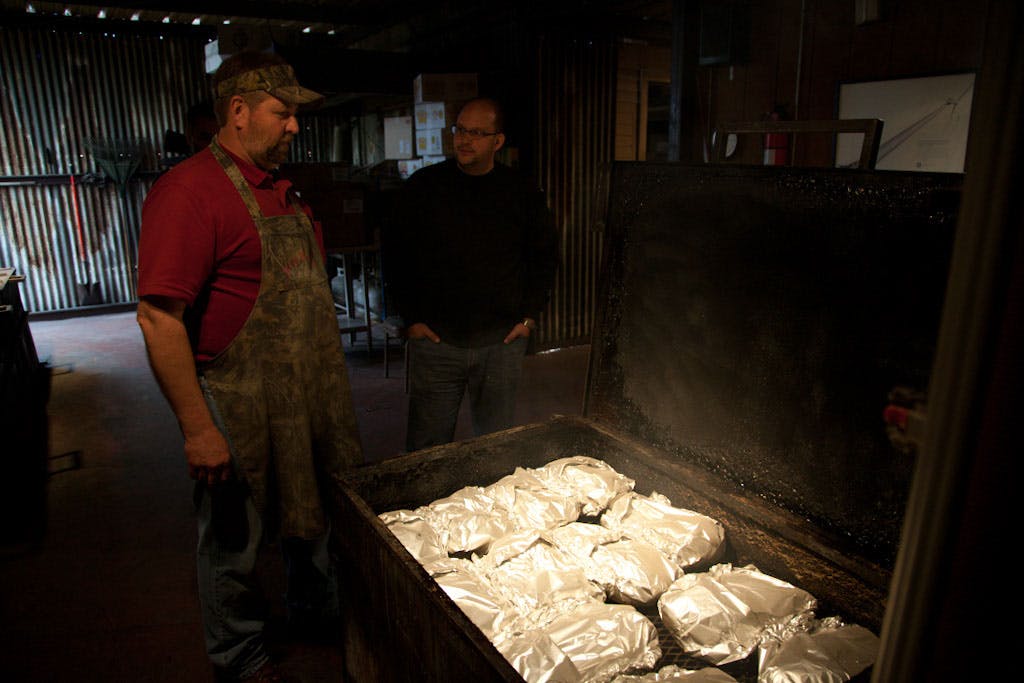
Some flavor memories are so intense that the setting doesn’t even matter. Last week I was standing on some synthetic grass in a parking lot behind a television studio in Hollywood. Lunch was a beef rib that tasted like it could have been cooked in Mason, Texas. It was hot on the pavement, but even hotter near the giant steel chimney where chef, friend and cookbook author Adam Perry Lang and his crew where making charcoal. It was pecan wood instead of mesquite like they’d use in the Hill Country, and the detached cooker was a cabinet with racks of alternating height, but the flavors were the same. Hot fat and wood coals creates the same chemical reaction in California as they do in Texas. I asked Lang if he considered what he was doing barbecue or grilling. He didn’t care. He was chasing flavors not boxing himself into a rigid methodology. He’d never cooked quite like this on this scale until he set up this summer-long pop-up barbecue joint in LA, but he liked the results, and so did I. His most recent book, Serious Barbecue, considers a number of live fire cooking styles, and, he writes, “’Barbecue’ does not just mean the slow-cooked, smoked perfumed meats of the South.”
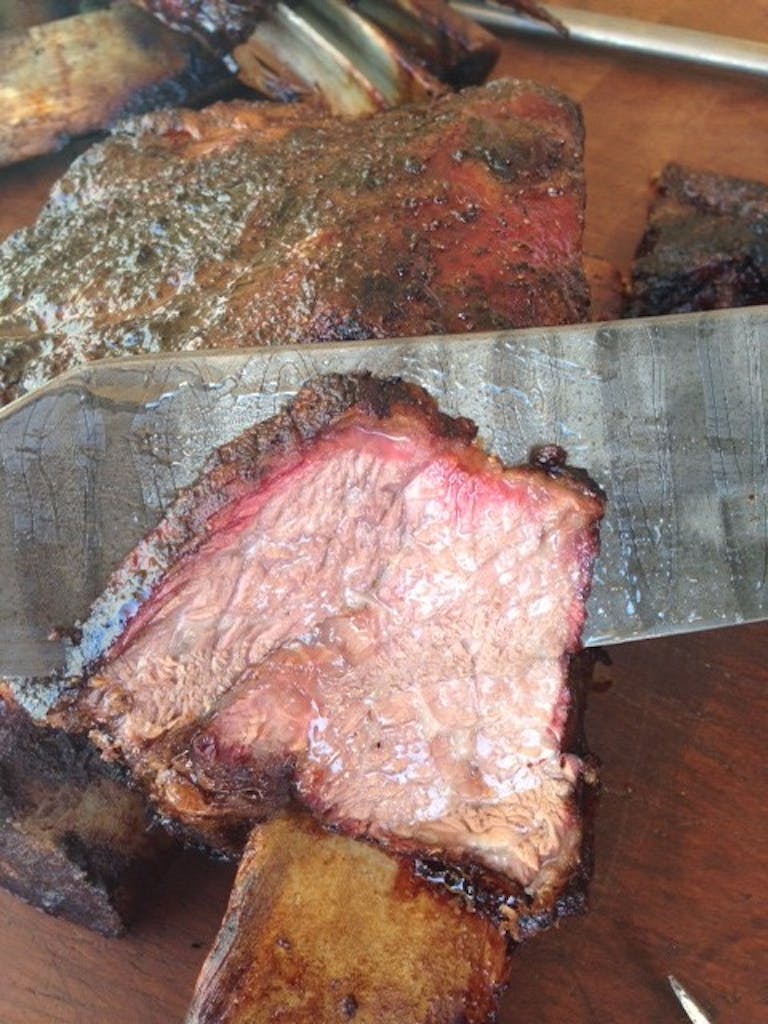
Steven Raichlen, another famous barbecue cookbook author, also keeps a similar open door policy to barbecue. His book The Barbecue Bible includes smoked and grilled recipes from all over the world. I cooked with Raichlen at his Barbecue University in Colorado Springs over the summer, and we used everything from charcoal and gas grills, to smokers and even shovels as cooking implements. I asked Raichlen how he defined barbecue. “Live fire cooking” was his simple response. He prefers to cook with wood, and offset smokers are his favorite for brisket. “I like the element of danger, and the inconvenience and effort of checking the fire every forty-five minutes” he quipped, but it’s all barbecue to him. As with Lang, the inclusiveness is not a surprise from a guy who included all things grilling in a book called The Barbecue Bible, but Raichlen does make one notable distinction for what defines grilling: “You can watch it being cooked.” It’s about the immediacy of seeing food transform with every passing second, unlike barbecuing which is more like watching paint dry. I have fewer arguments with his ideology these days than I did several years ago. I can’t find the link, but there was an open request for questions to Raichlen that he would answer online. My smart-ass question was something about why he wrote a book about grilling and put “barbecue” in the title. If he remembered that at all, he didn’t hint at it while he passed out diplomas at BBQ U.
One of Raichlen’s favorite Texas barbecue joints is Franklin Barbecue in Austin, which uses indirect heat, low and slow like every other joint in Central Texas. Oh, wait. There are even some in Central Texas that use direct-heat cooking over coals. Maybe you’ve heard of Snow’s BBQ in Lexington? Yes, that is a very large offset smoker that dominates the view from the picnic tables out back, but they only use that for briskets. Everything else is done over post oak coals, so if you’ve enjoyed the chicken and pork steaks there, they weren’t smoked, but they damn sure were barbecue.

I was in an argument just last month with someone who said the only good barbecue he found in Texas was at Perini Ranch Steakhouse. I quickly responded that it wasn’t barbecue, but now I’m not so sure. They burn mesquite down to coals then cook thick cut steaks directly over the coals. “But that’s steak,” you say. Yes it is, but so are the ribeyes they smoke at Louie Mueller and that famous prime rib that they smoke at Kreuz Market is bordering on fancy. I recently interviewed Tootsie Tomanetz of Snow’s BBQ about her history in barbecue. I asked about the meats she would put on the pits on Saturdays in her old meat market. I expected to hear her say brisket, shoulder clod and beef ribs, but she said “if T-bones weren’t selling well, that week we’d cut T-bones and put them on the pit, or use sirloins or ribeyes. We’d use any cuts of meat that did not sell well that week.” Would you be comfortable telling Tootsie that she wasn’t serving barbecue back then?
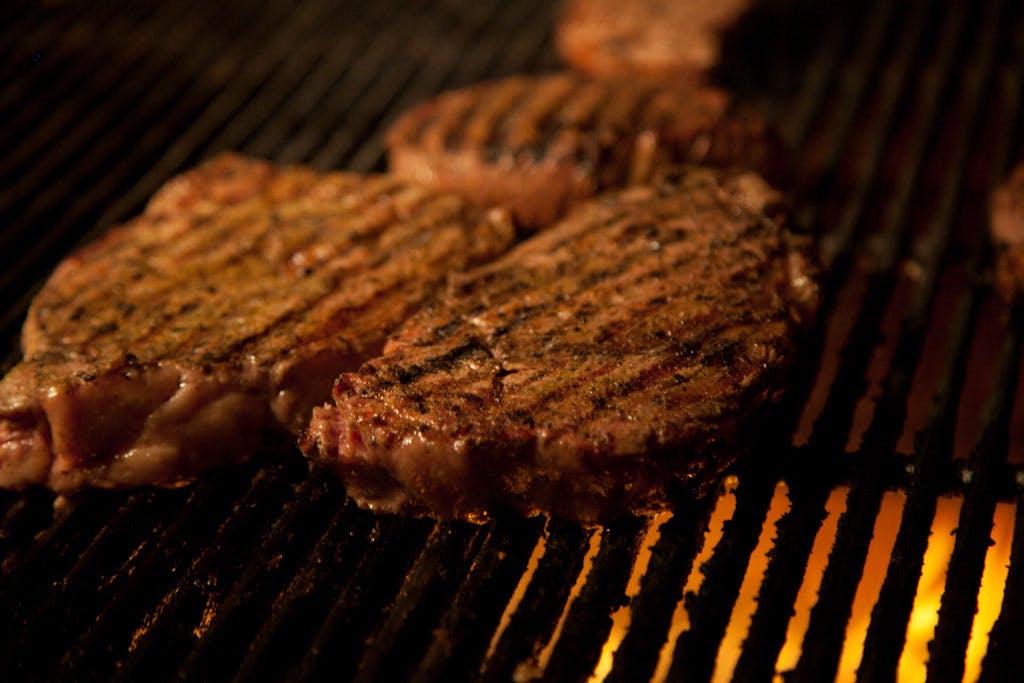
If you’re still grasping to tighten that definition of Texas barbecue, you may look to the government for help. There is an oft-quoted section of the Code of Federal Regulations (CFR) that defines barbecued meats:
§ 319.80 Barbecued meats. Barbecued meats, such as product labeled ‘‘Beef Barbecue’’ or ‘‘Barbecued Pork,’’ shall be cooked by the direct action of dry heat resulting from the burning of hard wood or the hot coals therefrom for a sufficient period to assume the usual characteristics of a barbecued article, which include the formation of a brown crust on the surface and the rendering of surface fat.
It goes on from there, but the definition is succinct. Barbecue is made with wood under dry heat conditions. It’s also exclusionary enough for folks to repeat it as the one and only true definition of barbecue. This is the definition given by the Kansas City Barbecue Society during the training session to become a certified barbecue judge. It sounds good until you realize that it just meant as a rule for labeling sorry looking tubs of pre-cooked meat at the supermarket. If we’re going to leave anything out the barbecue discussion, I’d like these products to go first. Also, if you look a little earlier in that CFR section you’ll find the government’s definition of meat. A portion of which states “meat does not include the muscle found in the lips, snout, or ears.” Try telling that to a vegetarian when you offer them a barbecued pig snout in St. Louis.
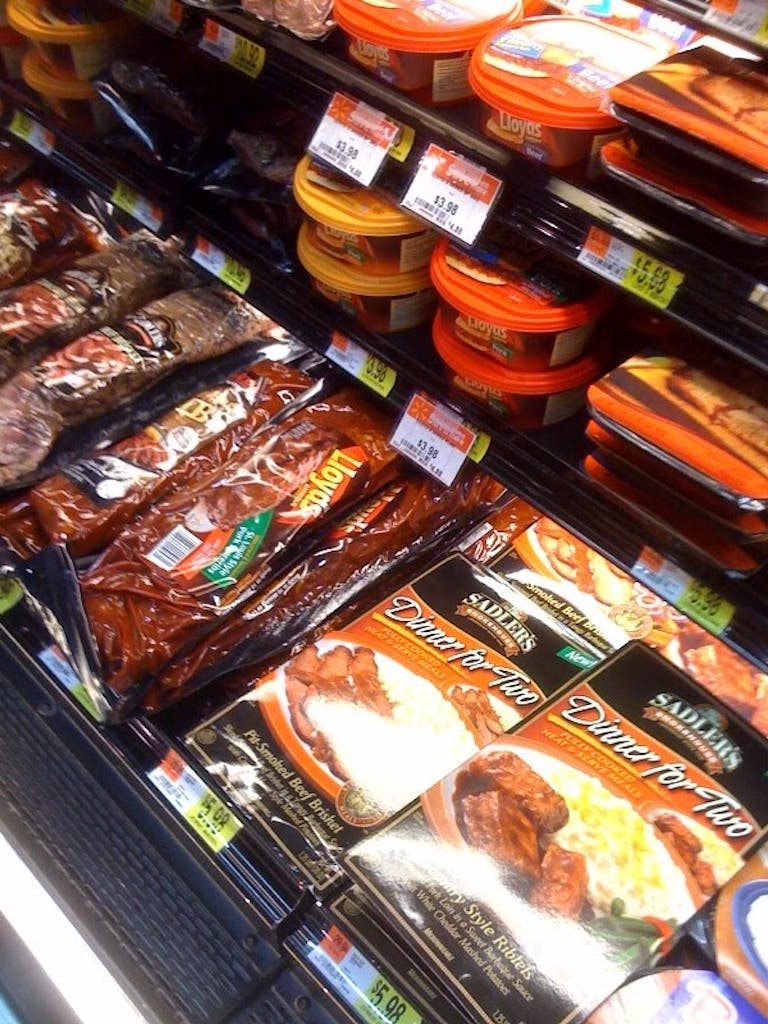
What are we left with that separates grilling from barbecue? Is it the fuel? Does it have to be made with wood to be Texas barbecue? I think as barbecue purists we’re more forgiving of gassers than charcoal when it comes to defining barbecue. However, I just did a review of Nathan’s BBQ in Brenham that uses almost entirely lump charcoal for fuel. It was undeniably barbecue. Bubba Roese and his crew in Washington–those purists that say barbecue can’t be smoked –use B&B lump charcoal for fuel.
I’m not arguing that hamburgers on a gas grill should enter the conversation, but let’s play devil’s advocate on the subject of hot dogs. We have no problem taking fully-cooked, pre-smoked sausages, warming them over a fire and calling it Texas barbecue. The only difference between that and grilling a hot dog is girth and the grinding method.
So, what is the difference between barbecue and grilling? I don’t know. I won’t give you some cop out answer of “I just know it when I see it” because as I see more of it, my perspective changes. I guess my point is that there doesn’t need to be a red line drawn between the two. Turn down the dogmatic volume and allow for a nuanced definition.


